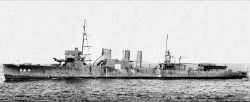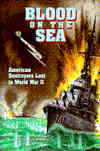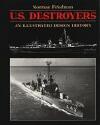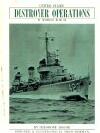Allied Warships
USS Stewart (i) (DD 224)
Destroyer of the Clemson class

USS Stewart seen here as japanese partrol boat No. 102
| Navy | The US Navy |
| Type | Destroyer |
| Class | Clemson |
| Pennant | DD 224 |
| Built by | William Cramp and Sons (Philadelphia, Pennsylvania, U.S.A.) |
| Ordered | |
| Laid down | 9 Sep 1919 |
| Launched | 4 Mar 1920 |
| Commissioned | 15 Sep 1920 |
| Lost | 2 Mar 1942 |
| History | USS Stewart had probably the most unusual duty of any American ship during WW2. She served the Japanese Empire. Unlike many of her sisterships, she was never decommissioned during the wars, serving in her entire life in the Pacific. In the early months of the war she served as an escort, and then was assigned to fleet activities, and in this role she participated in the Battle of Java Sea, in the force ABDA. On 19 February, 1942 this fleet was attacking landing forces at Bali. In this engagement she came under very accurate fire from Japanese destroyers, and suffered extensive damages to her hull, engine rooms, as well as to her armament. She kept on fighting, and escaped, reaching Surabaya on her own power. In the drydock, while being lifted, the shore collapsed, and Stewart (Lt.Cdr. Harold Page Smith) rolled to a 37 degree angle. Amazingly no one was hurt or killed, but more damage was done to her hull, and because of the rapidly advancing Japanese forces, she was left behind and blown up. At least so the American Navy thought. In reality she was recovered by the IJN, and after certain changes to her stacks and her armament (the IJN wanted to make sure she wouldn't be misidentified and attacked by their own forces) they commissioned her as Patrol Boat No. 102 (offsite link). She was never really patched up, only 2 of her four boilers were operational, but nevertheless she was seaworthy, and soon started ASW patrols around the Japanese-held islands in the Pacific. And soon American pilots started to file in reports about a strange, unrecognizable IJN destroyer, which strongly resembled to the old four-stack destroyers. These reports were dismissed. However, the story of the "Phantom Destroyer" was soon born. USS Stewart may have served well the United States of America - so did she serve the Japanese Empire. Although both cases are very far away from verified, she might have been involved in the sinking of at least two American submarines. One could be USS Harder (SS-257) on 24 August, 1944. Along with USS Haddo, she was operating in the vicinity of Dasol Bay. So did Patrol Boat No. 102, and the two US subs became under heavy depth charge attacks. USS Harder was never heard from again, and USS Haddo reported that a massive amount of around 400 depth charges were used in the attack. Although nothing confirms that some of it was dropped by Patrol Boat No.102, much less proof for delivering the fatal blow, it is very likely the the former US destroyer was involved in this engagement. In the other case she is strongly suspected to sink the famous USS Growler (SS-215) on 8 November, 1944, in the South China Sea. Although there is no confirmation, on this occasion there wasn't as many other IJN ships in the vicinity, making her a perfect candidate. On 28 April, 1945 she was at Mopko, Korea, when she was damaged by US aircraft. She limped back to Kure/Hiroshima for repairs, but never set sail again. She was there when the atomic bomb was dropped on Hiroshima. After reclaimed by the US Navy, there was a bit of confusion, nobody knew what to do with her. Some thought she should be preserved es a memorial, but finally she was used and sunk as a target ship off San Francisco on 24 May, 1946. |
Commands listed for USS Stewart (i) (DD 224)
Please note that we're still working on this section
and that we only list Commanding Officers for the duration of the Second World War.
| Commander | From | To | |
| 1 | Lt.Cdr. Donald Sidley Evans, USN | 16 May 1939 | 18 May 1940 |
| 2 | Lt.Cdr. Harold Page Smith, USN | 18 May 1940 | 2 Mar 1942 |
You can help improve our commands section
Click here to Submit events/comments/updates for this vessel.
Please use this if you spot mistakes or want to improve this ships page.
Notable events involving Stewart (i) include:
10 Jan 1942
Convoys MS 2 and MS 2A.
Convoy MS 2 departed Sydney on 10 January 1942.
This convoy was made up of only one ship, the troopship Aquitania (British, 44786 GRT, built 1914).
On departure from Sydney convoy MS 2 was escorted by the heavy cruiser HMAS Canberra (Capt. G.D. Moore, RAN).
Convoy MS 2 arrived at Fremantle on 15 January and departed again in the same composition on the 16th.
On 19 January 1942, while approaching the Sunda Strait the convoy was joined by a local escort made up of the light cruisers HMS Dragon (Capt. R.J. Shaw, MBE, RN), HrMs Java (Capt. P.B.M van Straelen, RNN) and the destroyers HMS Express (Lt.Cdr. F.J. Cartwright, RN) and HMS Thanet ( Cdr.(Retd.) B.S. Davies, RN) which came from Batavia.
On 20 January 1942, the destroyer HrMs Van Nes (Lt.Cdr. C.A. Lagaay, RNN) joined. The convoy arrived at Ratai Bay, Sumatra later the same day.
On arrival at Lampung Bay, HrMs Java and HMS Thanet parted company to proceed to Batavia to fuel on completion of which they returned to Ratai Bay. HMAS Canberra and HMS Express fuelled at Ratai Bay.
At Lampung Bay the troops from the Aquitania were put onto smaller ships which were to take them to Singapore as Convoy MS 2A.
These were the merchant vessels; Both (Dutch, 2601 GRT, built 1931), Reael (Dutch, 2561 GRT, built 1931), Reijnst (Dutch, 2462 GRT, built 1928), Sloet van Beele (Dutch, 2977 GRT, built 1914), Taishan (British, 3174 GRT, built 1925), Van der Lijn (Dutch, 2464 GRT, built 1928) and Van Swoll (Dutch, 2147 GRT, built 1930).
To provide cover for the operation of putting the troops on board the smaller ships the heavy cruiser HMAS Canberra, light cruisers HMS Dragon, destroyers HMS Express, HMAS Vampire (Cdr. W.T.A. Moran, RAN), USS Barker (Lt.Cdr. L.G. McGlone, USN), USS Stewart (Lt.Cdr. H.P. Smith, USN), HrMs Evertsen (Lt.Cdr. W.M. de Vries, RNN), HrMs Van Nes, sloops HMIS Jumna (Cdr. W.R. Shewring, RIN), HrMs Soemba (Cdr. P.J.G. Huijer, RNN) and the patrol vessel USS Isabel (Lt. J.W. Payne, Jr., USN) were patrolling / present in the Bay.
Around 1045GH, convoy MS 2A departed Ratai Bay for Singapore. It was escorted by HMAS Canberra, HMAS Vampire and HMIS Jumna.
Around 1830GH/21, HrMs Java and HMS Thanet joined from Batavia.
At 1000GH/23, after the convoy had passed the Banka Strait HMAS Canberra parted company leaving HrMs Java in command of the escort. HMAS Canberra then proceeded to Batavia where she arrived the following day.
The convoy arrived at Singapore late in the morning of the 24th. (1)
4 Feb 1942
At 0130 hours, the Dutch light cruisers HrMs De Ruyter (Cdr. E.E.B. Lacomblé, RNN and flagship of Rear-Admiral K.W.F.M. Doorman, RNN), HrMs Tromp (Cdr. J.B. de Meester, RNN) and the Dutch destroyers HrMs Piet Hein (Lt.Cdr. J.M.L.I. Chompff, RNN), HrMs Banckert (Lt.Cdr. L.J. Goslings, RNN) and HrMs Van Ghent (Lt.Cdr. P. Schotel, RNN) departed their anchorage to the north of of Gili Raja Island (Pulau Gili Raja) for the Java Sea.
At 0500 hours they made rendes-vous with the US heavy cruiser USS Houston (Capt. A.H. Rooks, USN), the US light cruiser USS Marblehead (Capt. A.G. Robinson, USN) and their escorting destroyers USS Stewart (Lt.Cdr. H.P. Smith, USN), USS John D. Edwards (Lt.Cdr. H.E. Eccles, USN), USS Barker (Lt.Cdr. A.J. Miller, USN) and USS Bulmer (Lt.Cdr. D.A. Harris, USN). These American ships had also been anchored the north of of Gili Raja Island (Pulau Gili Raja) but had left a little earlier then the Dutch ships. The mission of the joint Dutch-US task force was a 'hit and run' raid into Strait Makassar.
Around 0955 hours the task force came under air attack in the by the Japanese in the Bali Sea in approximate position 07°28'S, 115°37'E and USS Houston and USS Marblehead were damaged. Houston was hit on the roof of her rear 8" gun turret heavily damaging it and it could not be repaired. (When USS Houston sank about four weeks later she still had only two operational 8" gun turrets). USS Marblehead was hit twice and also straddled and received serious damage resulting in that she had to be sent to the USA for repairs. The raid into Makassar Stait was now cancelled.
USS Houston had been sent towards Tjilatjap (Cilacap) on the south coast of Java for repairs. USS Tromp was later ordered to give her protection during her passage there and proceeded after her. She caught up with her to the south of Atlas Stait and both ships then proceeded in company until 0000/5 when Tromp left USS Houston again and proceeded to re-join the task force as ordered which she did at 1325/5 when she made rendes-vous with HrMs De Ruyter and the three Dutch destroyers. (2)
9 Feb 1942
Around 0800 hours, HrMs De Ruyter (Cdr. E.E.B. Lacomblé, RNN and flagship of Rear-Admiral K.W.F.M. Doorman, RNN) and HrMs Tromp (Cdr. J.B. de Meester, RNN), were joined by eight US destroyers USS Whipple (Lt.Cdr. E.S. Karpe, USN), USS Pillsbury (Lt.Cdr. H.C. Pound, USN), USS Edsall (Lt.Cdr. J.J. Nix, USN), USS Alden (Lt.Cdr. L.E. Coley, USN), USS Stewart (Lt.Cdr. H.P. Smith, USN), USS John D. Edwards (Lt.Cdr. H.E. Eccles, USN), USS Barker (Lt.Cdr. A.J. Miller, USN) and USS Bulmer (Lt.Cdr. D.A. Harris, USN).
At 1700 hours the Dutch destroyers HrMs Piet Hein (Lt.Cdr. J.M.L.I. Chompff, RNN), HrMs Banckert (Lt.Cdr. L.J. Goslings, RNN) and HrMs Van Ghent (Lt.Cdr. P. Schotel, RNN) also joined. Van Ghent developed engine trouble and was later replaced by HrMs Kortenaer (Lt.Cdr. A. Kroese, RNN). (After repairs Van Ghent re-joined the task force on the 11th.)
Around 2130 hours the US destroyers USS Edsall and USS Alden were detached and sent to Tjilatjap. (2)
14 Feb 1942
Around 1300GH/14, the destroyers USS Stewart (Lt.Cdr. H.P. Smith, USN), USS John D. Edwards (Lt.Cdr. H.E. Eccles, USN), USS Barker (Lt.Cdr. A.J. Miller, USN) and USS Bulmer (Lt.Cdr. D.A. Harris, USN), USS Pillsbury (Lt.Cdr. H.C. Pound, USN) and USS Parrott (Lt.Cdr. J.N. Hughes, USN) arrived at Oosthaven to join the Allied Striking Force. (3)
14 Feb 1942
Around 1600 hours, an Allied task force, now made up of five cruisers; the Dutch light cruisers HrMs De Ruyter (Cdr. E.E.B. Lacomblé, RNN and flagship of Rear-Admiral K.W.F.M. Doorman, RNN), HrMs Java (Capt. P.B.M van Straelen, RNN), HrMs Tromp (Cdr. J.B. de Meester, RNN), the British heavy cruiser HMS Exeter (Capt. O.L. Gordon, MVO, RN) and the Australian light cruiser HMAS Hobart (Capt. H.L. Howden, CBE, RAN). They were escorted by a total of ten destroyers, four Dutch and six American; HrMs Van Ghent (Lt.Cdr. P. Schotel, RNN), HrMs Kortenaer (Lt.Cdr. A. Kroese, RNN), HrMs Piet Hein (Lt.Cdr. J.M.L.I. Chompff, RNN), HrMs Banckert (Lt.Cdr. L.J. Goslings, RNN), USS Stewart (Lt.Cdr. H.P. Smith, USN), USS John D. Edwards (Lt.Cdr. H.E. Eccles, USN), USS Barker (Lt.Cdr. A.J. Miller, USN), USS Bulmer (Lt.Cdr. D.A. Harris, USN), USS Pillsbury (Lt.Cdr. H.C. Pound, USN) and USS Parrott (Lt.Cdr. J.N. Hughes, USN) depared Oosthaven (Bandar Lampung), Sumatra for a hit and run raid to the north of the Gaspar Straits to attack a reported Japanese convoy. (2)
15 Feb 1942
Around 0315GH/15, the Allied Striking Force entered the Stolze Strait (to the east of Mendanau Island (Pulau Mendanau). The task force was clear of the strait around 0800GH/15 but not before the Dutch destroyer HrMs Van Ghent (Lt.Cdr. P. Schotel, RNN) had hit a reef around 0500GH/15 resulting in the loss of this vessel. The Dutch destroyer HrMs Banckert (Lt.Cdr. L.J. Goslings, RNN) remained behind to render assistance to her stranded sister but it was soon apparent that the ship was beyond salvage. Several valuable items of the equipment were however taken off and by 1700 hours the wreck of HrMs Van Ghent was destroyed by HrMs Banckert. The Banckert now made off for Surabaya with the crew of the Van Ghent on board.
Meanwhile around 1150GH/15, the first Japanese air attack on the remainder of the Allied Striking Force started. The attacks, which came in five waves, lasted until about 1745GH/15. No major damage was done to the Allied ships which had reversed course shortly after 1300GH/15. The Australian light cruiser HMAS Hobart reported some minor damage, mostly from splinters and the US destroyers USS Barker (Lt.Cdr. A.J. Miller, USN) and USS Bulmer (Lt.Cdr. D.A. Harris, USN) required repairs to their badly shaken up machinery spaces due to near misses.
The task force was then split up with HrMs De Ruyter (Cdr. E.E.B. Lacomblé, RNN and flagship of Rear-Admiral K.W.F.M. Doorman, RNN), HrMs Tromp (Cdr. J.B. de Meester, RNN), HMS Exeter (Capt. O.L. Gordon, MVO, RN), HMAS Hobart and the destroyers USS Barker and USS Bulmer proceeding to Batavia to refuel. HrMs Java (Capt. P.B.M van Straelen, RNN) and the remaining US destroyers (USS Stewart (Lt.Cdr. H.P. Smith, USN), USS John D. Edwards (Lt.Cdr. H.E. Eccles, USN), USS Pillsbury (Lt.Cdr. H.C. Pound, USN) and USS Parrott (Lt.Cdr. J.N. Hughes, USN)) proceeded to the Ratai Bay to refuel and the two remaining Dutch destroyers (HrMs Kortenaer (Lt.Cdr. A. Kroese, RNN) and HrMs Piet Hein (Lt.Cdr. J.M.L.I. Chompff, RNN)) to Oosthaven to do the same. (2)
19 Feb 1942
Battle of Badoeng Strait
It was expected that the Japanese would soon land (night of 19/20 February 1942) on the south-east coast of Bali (Badoeng Strait). Rear-Admiral Doorman therefore wanted to attack them in three waves. The first wave came from Tjilatjap on the south coast of Java and consisted of the Dutch light cruisers HrMs De Ruyter (Cdr. E.E.B. Lacomblé, RNN and flagship of Rear-Admiral K.W.F.M. Doorman, RNN) and HrMs Java (Capt. P.B.M van Straelen, RNN), escorted by the Dutch destroyers HrMs Piet Hein (Lt.Cdr. J.M.L.I. Chompff, RNN) and HrMs Kortenaer (Lt.Cdr. A. Kroese, RNN) as well as the US destroyers USS John D. Ford (Lt.Cdr. J.E. Cooper, USN) and USS Pope (Lt.Cdr. W.C. Blinn, USN). However while leaving Tjilatjap in the evening of the 18th the Dutch destroyer Kortenaer grounded and was only able to get of at high tide therefore was no longer part of this force.
The second wave was made up of the Dutch light cruiser HrMs Tromp (Cdr. J.B. de Meester, RNN) and four US destroyers; USS Stewart (Lt.Cdr. H.P. Smith, USN), USS Parrott (Lt.Cdr. J.N. Hughes, USN), USS Pillsbury (Lt.Cdr. H.C. Pound, USN) and USS John D. Edwards (Lt.Cdr. H.E. Eccles, USN). They sailed from Surabaya in the afternoon of the 19th
Finally the third wave was made up of the Dutch Motor Torpedo Boats; HrMs TM-4 (Lt. J.E. Gobée, RNN), HrMs TM-5 (S.Lt. E.J. Hoeksel, RNN), HrMs TM-6 (S.Lt. P. van Rees, RNN), HrMs TM-8 (Lt. J.G. Treffers, RNN), HrMs TM-9 (Lt. J.A. van Beusekom, RNN), HrMs TM-10 (S.Lt. J.W. Boon, RNN(R)), HrMs TM-11 (S.Lt. A.A.F. Schmitz, RNN), HrMs TM-15 (Lt. H.C. Jorissen, RNN). HrMs TM-13 (?) was also part of this force but acted as 'rescue boat'. Shortly after their sailing from Surabaya in the evening of the 18th HrMs TM-6 was forced to return due to engine trouble. These Motor Torpedo Boats proceeded through Strait Bali and anchored in three bay's on the Java side to refuel which took the whole day. In the evening of the 19th they departed for Badoeng Strait.
The Japanese attack on Bali was carried out by two transport ships Sasako Maru (7180 GRT, built 1941) and Sagami Maru (7189 GRT, built 1940). They had on board part of the Imperial Japanese Army’s 48th Infantry Division and had departed Makassar for Bali during the night of 17/18 February. They were escorted by four destroyers; Asashio (Lt.Cdr. G. Yoshii), Oshio (Cdr. K. Kikkawa) Arashio (Cdr. H. Kuboki) and Michishio (Lt.Cdr. M. Ogura). Distant cover was provided by the light cruiser Nagara (Capt T. Naoi, flagship of Rear-Admiral K. Kubo) escorted by three destroyers Hatsushimo (Lt.Cdr. S. Kohama), Nenohi (Lt.Cdr. T. Chihagi) and Wakaba (Lt.Cdr. M. Kuroki).
The Japanese landed around 0200/19 on the south coast of Bali. The transports were attacked unsuccessfully by the American submarine USS Seawolf. Seawolf herself was then counter attacked with depth charges by the destroyers but managed to escape.
During the day the Japanese transports were attacked from the air and the Sagami Maru was damaged. She left the landing zone escorted by the destroyers Arashio and Michishio. The undamaged Sasako Maru remained in the landing zone to pick up the landing barges. The destroyers Asashio and Oshio remained with her.
The allied first attack wave arrived south of Bali around 2130/19. A line was then formed in the order, HrMs De Ruyter, HrMs Java, HrMs Piet Hein, USS John D. Ford and finally USS Pope. Speed was increaded to 27 knots and they proceeded up Badoeng Strait. Around 2230 hours HrMs De Ruyter and HrMs Java opened fire on the Japanese which were taken by surprise. The Asashio turned a searchlight on which was quickly taken out by a salvo from the Java. The Dutch cruisers claimed heavy damage on the enemy but according to Japanese reports on the battle damage was only minor and after being initially taken by surprise the Japanese soon counter attacked. By that time however the Dutch cruisers had moved on.
The Allied destroyers were further behind the cruisers then intended and now arrived on the scene. Piet Hein was a little ahead of the US destroyers and opened fire with her 4.7” guns and also fired two torpedoes. Shortly afterwards two more torpedoes were fired but none found their intended target. Piet Hein then turned around towards the US destroyers with the intention to attack the Japanese again. While doing so her smoke generator was started. It is not completely clear but it is possible that one of these US destroyers then engaged Piet Hein with gunfire thinking she was Japanese. It is also possible that it were the Japanese that engaged Piet Hein. At this time Piet Hein was hit several times, resulting in her to come to a stop. After about 15 minutes Piet Hein was illuminated by a Japanese searchlight and taken under fire. The crew was ordered to abandon the doomed destroyer and she soon sank.
USS John D. Ford and Pope sighted a Japanese transport vessel (this must have been the Sasaga Maru) and what they thought to be a Japanese cruiser but this must have been the destroyer Oshio. They launched torpedoes (Ford – three, Pope - five) and turned away. Asashio and Oshio when went after them. The Americans thought they faced a very powerful enemy, even heavy cruisers were thought to be present. Both destroyers then retired to the south-east to return to Tjilatjap. Shortly afterwards they heard gunfire. This gunfire was coming from both Japanese destroyer that were now engaging each other by mistake. After a few minutes the mistake was noticed and both Japanese destroyer retired up the Strait to the north.
Meanwhile the Allied second attack wave was nearing the scene of the action. They had arrived south of Bali around 0100/20. The four US destroyers were ahead of the Tromp. It was intended that the four US destroyer would enter Badoeng Strait and attack with torpedoes first and that the Tromp would come behind them to finish off the Japanese after the confusion of the torpedo attack. During the torpedo attack a total of fifteen torpedoes were fired, six each by USS Stewart and USS Pope and three by USS Pillsbury. Their targets, Asashio and Oshio were not hit and both Japanese destroyers now went after their attackers. Stewart was then hit with gunfire. The US destroyers then set course to the east to leave Badoeng Strait. Now Tromp went in. Soon she was illuminated by a searchlight and the Japanese opened fire. Thy obtained eleven hits on the Tromp causing heavy damage to the Dutch cruiser. The Oshio on her turn was seriously damaged by the Tromp. The action was over around 0215/20 and Tromp retired from the Strait to the north-east. When north of Bali she went to full speed and returned to Surabaya for repairs.
Japanese Rear-Admiral Kubo, on board the Nagara, had meanwhile ordered the Arashio and Michishio to return to Badoeng Strait (Nagara and her three escorting destroyers were too far off). When the two Japanese destroyers entered the Strait they encountered the four US destroyers. Both sides launched torpedoes but all missed their intended targets and then a gunfight was started. During this gunfight the Michishio was heavily damaged and in the end she had to be towed back to Makassar. The US destroyer meanwhile continued to retire from the area.
The third wave then entered the Strait. The Dutch MTB’s had seen the second wave attacking but when they entered Badoeng Strait the Japanese were not sighted and they left without being able to fire torpedoes.
The Allies were at that time under the impression that they had obtained a victory. They thought to have sunk a Japanese cruiser and have damaged two more cruisers and two destroyers. This was not the case, one Japanese destroyer was heavily damaged and one seriously. In return the Japanese sank a Dutch destroyer and damaged the Dutch cruiser Tromp heavily. As the Dutch naval base at Surabaya was now under daily air attack it was deemed wise to sent the Tromp to Australia for repairs.
Media links
|
|
|
|
Sources
- Report of proceedings of HMAS Canberra for January 1942 + Report of proceedings of HMAS Vampire for January 1942
- Files 2.12.03.6849 and 2.12.27.121 (Dutch Archives, The Hague, Netherlands)
- Report of proceedings of HMAS Hobart for February 1942
As an Amazon Associate uboat.net earns a commission from qualifying purchases.





